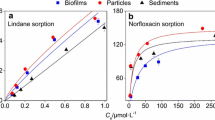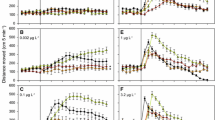Abstract
Research was conducted to assess the importance of suspended solids (ss) types and levels and associated organic carbon contents on the bioavailability of chlordane toDaphnia magna. The dose response relationship ofD. magna to chlordane was established in the absence of suspended solids. Test waters with suspended solids levels of approximately 0, 100, 500, and 750 mg/L contained a chlordane concentration which caused ∼80% mortality of the test population in 48-hr. The effects of different types and levels of suspended solids onD. magna mortality were observed. Both montmorillonite clay (0 organic carbon) and pond sediments (1.7% organic carbon) reduced bioavailability of chlordane toD. magna. Suspended solids characteristics were not a determining factor In the reduction of the bioavailability of chlordane toD. magna as long as a threshold level (>200 to 300 mg/L) of suspended solids was present.
Similar content being viewed by others
References
Adams WJ (1985) Bioavailability and safety assessment of lipophillic organics sorbed to sediments. In: Dickson KL, Maki AW, Brungs B (eds) Fate and Effects of Sediment-Bound Chemicals in Aquatic Systems. Pergamon, New York, New York (in press)
American Public Health Association (APHA), American Water Works Association, Water Pollution Control Federation (1980) Standard Methods for the Examination of Water and Wastewater. American Public Health Association, Washington, DC
Black CA, Evans DD, White JL, Ensmigler LE, Clark FE (eds) (1965) Methods of Soil Analysis: Parts 1 and 2, American Society of Agronomy, Madison, Wisconsin
Brown VM, Shaw TL, Sheabun DG (1974) Aspects of water quality and the toxicity of copper to rainbow trout. Wat Res 8:797–803
Burns LA (1982) Identification and evaluation of fundamental transport and transformation process models. In: Dickson KL, Maki AW, Cairns J Jr. (eds) Modeling the Fate of Chemicals in the Aquatic Environments. Ann Arbor Science, Ann Arbor, Michigan
Hamelink JL (1980) Bioavailability of chemicals in aquatic environments. In: Maki AW, Dickson KL, Cairns J Jr. (eds) Biotransformation and Fate of Chemicals in the Aquatic Environment. Ann Arbor Science, Ann Arbor, Michigan
Karickhoff SW, Brown DS, Scott TA (1979) Sorption of hydrophobic pollutants on natural sediments. Wat Res 13:241–248
Pickering QH, Henderson C (1966) The acute toxicity of some heavy metals to different species of warmwater fishes. Int J Air Water Pollut 10:453–463
Schuytema GS, Melson PO, Malueg KW, Mebeker AY, Krauczyk DF, Ratcliff AK, Gakstatter JH (1983) Toxicity of cadmium in water sediment slurries toDaphnia magna. Environ Toxicol Chem 3:293–308
Sharom MS, Miles JRW, Harris CR and McEwen FL (1980) Behaviour of twelve insecticides in soil and sediment. Wat Res 14:1095–1100
Spacie A and Hamelink JL (1985) Bioaccumulation. In: Rand GM and Petrocelli SR (eds) Fundamentals of Aquatic Toxicology. Chemosphere Publishing Co, Washington, DC, pp 495–525
Sprague, JB (1969) Measurements of pollutant toxicity to fish. I—Bioassay methods for acute toxicity. Wat Res 3:797–821
Staples CA, Dickson KL, Rodgers JR Jr, and Saleh F (1985) A model for predicting the influence of suspended sediment on bioavailability of neutral organic chemicals in the water compartment. In: Caldwell RD, Bahner RC and Purdy RE (eds), Aquatic Toxicology and Hazard Assessment (ASTM Symp 7, STP 854). Philadelphia, PA, pp 417–428
US Environmental Protection Agency (1975) Methods for acute toxicity tests with fish, macroinvertebrates, and amphibians. EPA 600/3-75-009, USEPA, Washington, DC, 32 PP
— (1983) Water quality standards handbook. USEPA Office of Water Regulations and Standards, Washington, DC
— (1984) Methods for measuring acute toxicity of effluents to aquatic organisms. USEPA Environmental Monitoring and Support Lab, Cincinnati, OH
United States Geological Survey (1983) Quality of rivers of the United States, 1976 Water Year. United States Geological Survey Report 80-594, Branch of Quality of Water, Reston, Virginia, 423 pp
Zar JH (1974) Biostatistical analysis. Prentice-Hall, Englewood Cliffs, NJ, 619 pp
Author information
Authors and Affiliations
Rights and permissions
About this article
Cite this article
Hall, W.S., Dickson, K.L., Saleh, F.Y. et al. Effects of suspended solids on the bioavailability of chlordane toDaphnia magna . Arch. Environ. Contam. Toxicol. 15, 529–534 (1986). https://doi.org/10.1007/BF01056566
Received:
Revised:
Issue Date:
DOI: https://doi.org/10.1007/BF01056566




